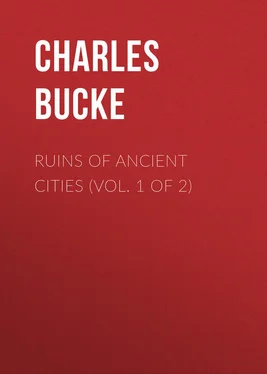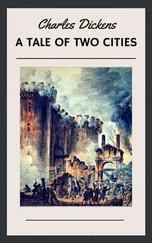Charles Bucke - Ruins of Ancient Cities (Vol. 1 of 2)
Здесь есть возможность читать онлайн «Charles Bucke - Ruins of Ancient Cities (Vol. 1 of 2)» — ознакомительный отрывок электронной книги совершенно бесплатно, а после прочтения отрывка купить полную версию. В некоторых случаях можно слушать аудио, скачать через торрент в формате fb2 и присутствует краткое содержание. Жанр: foreign_antique, foreign_prose, на английском языке. Описание произведения, (предисловие) а так же отзывы посетителей доступны на портале библиотеки ЛибКат.
- Название:Ruins of Ancient Cities (Vol. 1 of 2)
- Автор:
- Жанр:
- Год:неизвестен
- ISBN:нет данных
- Рейтинг книги:4 / 5. Голосов: 1
-
Избранное:Добавить в избранное
- Отзывы:
-
Ваша оценка:
- 80
- 1
- 2
- 3
- 4
- 5
Ruins of Ancient Cities (Vol. 1 of 2): краткое содержание, описание и аннотация
Предлагаем к чтению аннотацию, описание, краткое содержание или предисловие (зависит от того, что написал сам автор книги «Ruins of Ancient Cities (Vol. 1 of 2)»). Если вы не нашли необходимую информацию о книге — напишите в комментариях, мы постараемся отыскать её.
Ruins of Ancient Cities (Vol. 1 of 2) — читать онлайн ознакомительный отрывок
Ниже представлен текст книги, разбитый по страницам. Система сохранения места последней прочитанной страницы, позволяет с удобством читать онлайн бесплатно книгу «Ruins of Ancient Cities (Vol. 1 of 2)», без необходимости каждый раз заново искать на чём Вы остановились. Поставьте закладку, и сможете в любой момент перейти на страницу, на которой закончили чтение.
Интервал:
Закладка:
It has been well observed, that, associated in the youthful mind with all that is noble in patriotism, exalted in wisdom, excelling in art, elegant in literature, luminous in science, persuasive in eloquence, and heroic in action, the beautiful country of Greece, and its inhabitants, must, under every circumstance, even of degradation, be an interesting object of study. "We can all feel, or imagine," says Lord Byron, "the regret with which the ruins of cities, once the capital of empires, are beheld. But never did the littleness of man, and the vanity of his very best virtues, of patriotism to exalt and of valour to defend his country, appear more conspicuous than in the record of what Athens once was, and the certainty of what she now is."
The former state of Athens is thus described by Barthelemy. "There is not a city in Greece which presents so vast a number of public buildings and monuments as Athens. Edifices, venerable for their antiquity, or admirable for their elegance, raise their majestic heads on all sides. Masterpieces of sculpture are extremely numerous, even in the public places, and concur with the finest productions of the pencil to embellish the porticoes of temples. Here every thing speaks to the eyes of the attentive spectator."
To describe Athens entire would be to fill a volume. We shall, therefore, only give an account of the chief monuments of antiquity as they existed till very lately; the rest, as they give one little or no sort of idea of their ancient magnificence, were better omitted than mentioned.
The Piræus 56 56 Dodwell.
is one of the finest ports in Greece, and, being bounded by rocks, has experienced hardly any change in its form or dimensions. The sea, however, appears to have encroached a little, as some ruins are seen under water. The general depth of the port is from two to ten fathoms, in some places twenty. The Piræus was decorated with a theatre, several temples, and a great number of statues. As the existence of Athens depended on the safety of this harbour, Themistocles secured it against sudden attack by building a wall, sixty stadia in length, and forty cubits high. As to its thickness, it was greater than the space occupied by two waggons. It was built of huge square stones, fastened together on the outside by iron and leaden cramps. Without the gate was a cenotaph, erected in honour of Euripides, on which was inscribed "The glory of Euripides has all Greece for a monument."
The old city of Athens was seated on the top of a rock in the midst of a pleasant plain, which, as the number of inhabitants increased, became full of buildings, which induced the distinction of Acro and Catapolis, i. e. , of the upper and lower city.
The inside of the citadel was adorned with a multitude of edifices. The flat space on the rock of the Acropolis is not more than eight hundred feet in length, and about four hundred feet in breadth, – a small extent for the site of the primitive city of the Athenians; but an area of great size, when considered as the base only of temples and marble palaces, containing not a single structure which might not be denominated a masterpiece of art 57 57 Hobhouse.
. The most remarkable of these were a magnificent temple of Minerva, styled Parthenon, because that goddess was a virgin – this the Persians destroyed, out it was rebuilt with still greater splendour by Pericles – the temple of Neptune and Minerva jointly; a temple dedicated to Victory, adorned with paintings, principally the work of Polygnotus, and constructed of white marble. Within the citadel, also, was an immense number of statues, erected by religion and gratitude, on which the chisels of Myron, Phidias, Alcamenes, and other artists of renown, seemed to have bestowed animation. Of these statues, some were those of famous Athenian generals; such as Pericles, Phormio, Iphicrates, and Timotheus; and others, those of the gods.
It appears surprising that so many temples should have been crowded together within the narrow compass of the Athenian Acropolis; but the Roman Capitol, though not much more spacious, contained at least thirty temples 58 58 Dodwell.
.
"In its pride and glory," says Chandler, "the Acropolis appeared as one entire offering to the deity, surpassing in excellence, and astonishing in richness. Heliodorus employed on it fifteen books. The curiosities of various kinds, with the pictures, statues, and pieces of sculpture, were so many and so remarkable, as to supply Polemo Periegetes with matter for four volumes; and Strabo affirms, that as many more would be required in treating of Athens and of Attica.
As the stranger draws near to the present entrance of the citadel, he passes before the façade of the Propylea; the old entrance to the Acropolis, between its Doric pillars, being walled up. Pausanias says, "There is only one entrance to the Acropolis of Athens; it being in every remaining part of its circuit a precipice, and fortified by strong walls. This entrance was fronted by a magnificent building, called the Propylea, covered with roofs of white marble, which surpassed, for beauty and the dimensions of the marble, all that I have seen." This is now in ruins.
This was the most expensive work undertaken by Pericles, and is said to have cost 2,500 talents (£452,700). It took five years in building, and was completed B. C. 437.
"To a person who has seen the ruins of Rome," says Dr. Clarke, "the first suggestion, made by a sight of the buildings in the Acropolis, is that of the infinite superiority of the Athenian architecture. It possesses the greatness and majesty of the Egyptian or of the ancient Etruscan style, with all the elegant proportion, the rich ornaments, and the discriminating taste of the most splendid era of the arts." Its present condition is thus described by Mr. Williams. "The scene of desolation in the Acropolis is complete; the heaps of ruins of wretched houses, and various buildings, are constructed part with clay and marble, the marble looking doleful through the mud. On entering the temple one is struck by the worn steps, and curved or circular marks of the great doors of old; the pavement, too, that had been trodden by the luminaries of Greece."
The walls of the Acropolis 59 59 Clarke.
exhibit three distinct periods of construction; that is to say, the masonry of modern times in the repairs, – a style of building which can only be referred to the age of Cimon , or of Pericles ; – and the ancient Pelasgic work, as mentioned by Lucian. The modern walls of the city are about ten feet high, and not two in thickness. They were constructed about the year 1780, as a defence against pirates and hordes of Arnauts, who sometimes entered the town at night, and threatened to pillage it. The walls embrace a circuit of nearly three miles, and enclose not only the town and citadel, but also some open spaces for cattle. They were built in seventy-five days, all hands being employed night and day. All kinds of materials which were at hand were employed in their construction, and in some places they exhibit large blocks of stone and marble, and several fragmental inscriptions 60 60 Dodwell.
.
The lower city had thirteen gates, and among the principal edifices which adorned it were, 1. The Olympian temple, erected in honour of Athens and all Greece. 2. The Pantheon, dedicated to all the gods; a noble structure, supported by one hundred and twenty marble pillars, and having over its great gateway two horses, carved by Praxiteles. 3. The temple of Theseus; a noble structure, of Pentelic marble.
The Gymnasia of Athens were many, but the most remarkable were the Lyceum, Academia, and Cynosarges. The Lyceum stood on the banks of the Ilissus; some say it was built by Pisistratus; others by Pericles; others by Lycurgus.
Читать дальшеИнтервал:
Закладка:
Похожие книги на «Ruins of Ancient Cities (Vol. 1 of 2)»
Представляем Вашему вниманию похожие книги на «Ruins of Ancient Cities (Vol. 1 of 2)» списком для выбора. Мы отобрали схожую по названию и смыслу литературу в надежде предоставить читателям больше вариантов отыскать новые, интересные, ещё непрочитанные произведения.
Обсуждение, отзывы о книге «Ruins of Ancient Cities (Vol. 1 of 2)» и просто собственные мнения читателей. Оставьте ваши комментарии, напишите, что Вы думаете о произведении, его смысле или главных героях. Укажите что конкретно понравилось, а что нет, и почему Вы так считаете.












